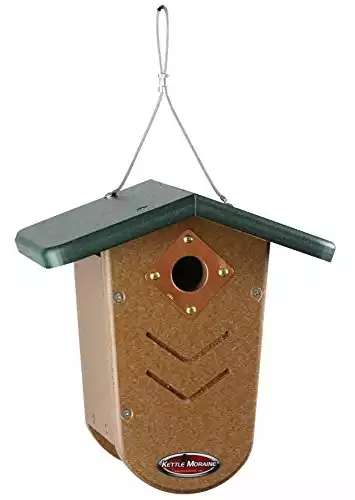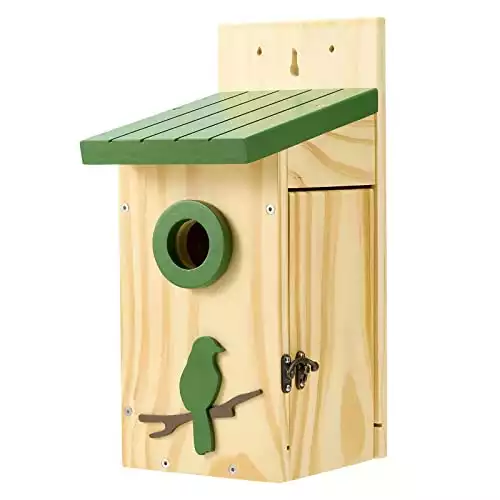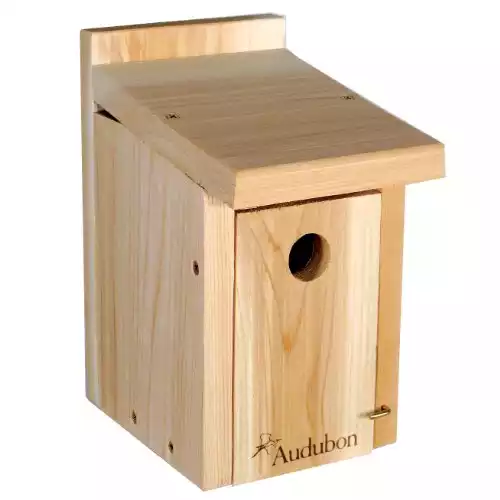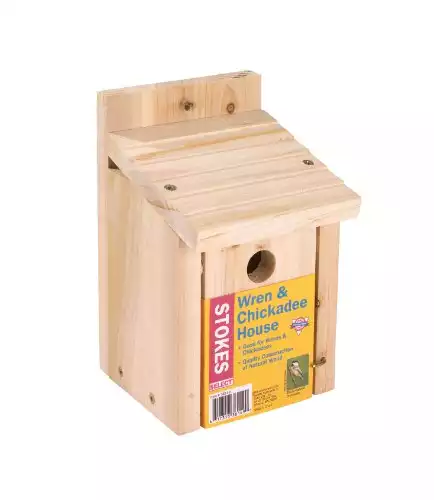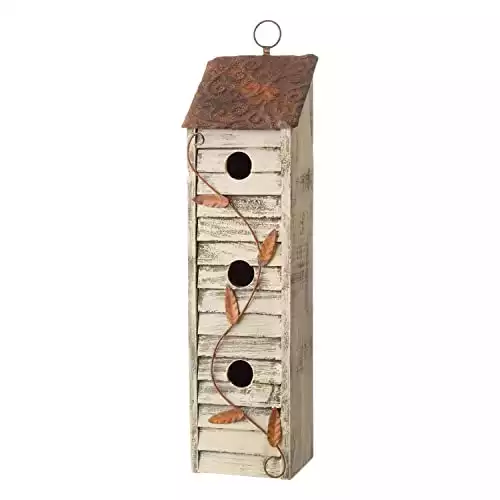Chickadees are cavity-nesting birds, which means they build their nests in rotted trees or other safe local cavities. Build a chickadee bird house with natural wood and an entry hole no bigger than 1.125 inches, this will help keep other birds out of the box.
These backyard birds are beloved by birders because they’re friendly, adorable, and stick around for those cold winters.
Check out our list of the best chickadee bird houses to buy as well as our tips on how to build a chickadee nest and ensure that they actually use it!
Chickadee Bird Houses – Comparison Table
|
|
|
|
|
|
|
Pros:
|
Pros:
|
Pros:
|
Pros:
|
Pros:
|
- Ideal entry size for chickadees
- The attractive copper portal works as a deterrent against potential predators
- The side opening allows for easy access to the interior
- Stay-clear, crack-resistant window
- Predator guard
- The use of natural wood, especially New Zealand Pine, enhances the overall aesthetics of the birdhouse
- Weather-resistant natural cedar wood
- Built to Audubon specifications environment
- The hinged roof simplifies maintenance
- Handcrafted construction
- Predator guards and a lockable front door
- Front-opening feature allows for easy access to the interior
- Attractive rustic design perfect for backyards
- Simple installation process
- Artisanal craftsmanship and eco-friendly materials
Our Top Picks
1. Kettle Moraine Recycled Bird House Nest for Wrens & Chickadees
- Recycled material
- Perfect entrance hole size
- Excellent drainage and ventilation
- Attractive copper portal
- Stainless steel cable for hanging
- Post mounting option
- Easy cleaning
This option is tailored to the preferences and nesting habits of wrens and chickadees, offering them an inviting and secure environment for nesting and raising their young.
This birdhouse is constructed using recycled materials, making it an eco-friendly option for bird enthusiasts.
It is designed with a specific entry hole size of 1-1/8 inches, making it ideal for attracting and accommodating chickadees and wrens while preventing larger bird species from using the nesting box. The attractive copper portal around the entrance serves a dual purpose – maintaining the entrance size for targeted bird species and acting as a deterrent to keep out potential predators.
The birdhouse features a side opening that facilitates easy access to the interior, making it convenient for users to clean and maintain the nesting box without causing disturbance to the nesting birds.
This option comes with a stainless steel cable for easy hanging, allowing users to position it in their preferred location. In addition to hanging, the birdhouse can also be post-mounted from the rear, offering users flexibility in choosing the best mounting method for their garden or yard.
Pros
- Designed with a 1-1/8 inch entry hole size, which is ideal for chickadees
- The attractive copper portal around the entrance not only adds a decorative touch but also acts as a deterrent against potential predators
- The side opening is very convenient for easy access to the interior
Cons
- No issues reported by users
2. Kingsyard Classic Bird House with Predator Guard
- High-quality natural wood
- Ventilation
- Easy cleaning and watching
- Ideal nesting environment
- Natural look
The Kingsyard Classic bird house offers several features that make it an attractive option for attracting and protecting specific bird species, including chickadees, in your garden.
The birdhouse is crafted from thick, solid wood made of New Zealand Pine. This sturdy construction ensures durability and provides a natural and attractive look.
The birdhouse is designed with air vents that allow for maximum airflow through the wall and floor openings. This ventilation feature creates a comfortable and optimal environment for bird health.
It comes with an easy-open lid, providing quick and effortless access for cleaning. Additionally, the stay-clear, crack-resistant window allows you to observe the birdhouse’s inhabitants without disturbing them.
It also features a safety extension around the entrance hole, which serves as a predator guard. This added protection helps keep young birds safe from potential predators.
Pros
- The stay-clear, crack-resistant window offers users the ability to watch the activities of the nesting birds without causing disturbance
- The presence of a predator guard can provide peace of mind to users
- The use of natural wood, especially New Zealand Pine, enhances the overall aesthetics of the birdhouse
Cons
- The paint tends to peel off after some time outside
3. Woodlink Audubon Cedar Wren and Chickadee House
- Natural cedar construction
- Rustic and natural appearance
- Ventilated design
- easy to clean
- Built to Audubon specifications
The birdhouse is made of natural cedar wood, which is a durable and weather-resistant material. The dimensions of the birdhouse provide sufficient space for wrens and chickadees to nest comfortably.
It’s designed with proper ventilation to ensure adequate airflow, preventing the nesting area from becoming too hot and promoting a healthy nesting environment for the birds.
The birdhouse features a hinged roof, making it convenient for birdwatchers to maintain and keep the house clean for new inhabitants.
Being built to Audubon specifications, it means that the birdhouse meets certain standards for bird conservation and habitat protection, making it a suitable choice for bird enthusiasts and conservation-minded individuals.
Pros
- The use of natural cedar wood provides a durable and weather-resistant birdhouse with a rustic and attractive appearance
- The fact that the birdhouse is built to Audubon specifications reassures users that it’s suitable nesting environment
- The hinged roof simplifies maintenance
Cons
- While cedar wood is known for its durability, some users may find that the birdhouse weathers over time, affecting its appearance
4. Stokes Select Wren & Chickadee Nesting Bird House
- Predator guards and lockable front door
- Ventilation design
- Drainage feature
- Front door steps for fledglings
- Mounting hardware included
The Stokes Select Wren & Chickadee nesting bird house offers a range of great features that make it an attractive option for attracting and providing a comfortable nesting space for various small bird species, including bluebirds, tree swallows, titmice, wrens, chickadees, and nuthatches.
The front-opening design is particularly beneficial for birdwatchers and bird enthusiasts, as it allows them to check on the nesting birds, monitor the nesting process, and clean the birdhouse without causing unnecessary disturbance to the nesting birds.
The front door of the birdhouse is also designed with built-in steps on the inside, allowing baby birds to climb up when they are ready to leave the nest.
The birdhouse is equipped with predator guards around the entrance hole and a lockable front door, providing added protection for nesting birds and their eggs by keeping potential predators out of the nesting box.
It features good ventilation to prevent overheating and built-in drainage to keep moisture and water from accumulating inside the nesting box.
The birdhouse comes with mounting hardware, making it easy to install and position in your desired location.
Pros
- Handcrafted construction and quality materials
- The presence of predator guards and a lockable front door provides users with peace of mind
- Front-opening feature, it allows for easy access to the interior of the birdhouse for cleaning and monitoring nesting activity
Cons
- A few durability concerns due to the natural wood construction
5. Glitzhome Wooden Three-Tier Hanging Bird House
- Natural and handmade construction
- Vintage and elegant design
- Easy installation and cleaning
- Ample space for nesting birds
- Back panel opening
The Glitzhome wooden three-tier hanging bird house is a decorative birdhouse designed to add charm and appeal to your garden or outdoor space.
The birdhouse is crafted from natural wood, and the wooden planks for the house body are chipped and painted by hand, adding to its unique character. Metal pieces are used to strengthen the roof part, making the birdhouse sturdy and durable while protecting it from the elements and potential damage.
With dimensions of 5″L x 4″W x 18″H, the birdhouse provides ample space for nesting birds such as chickadees.
The birdhouse is designed for easy installation with a hanging ring at the top. Users can attach it to a desired location, such as a tree, house, or banner, using rope or a hook. For maintenance, the back panel opens with a concealed door, allowing for straightforward cleaning without the need for tools.
Pros
- The attractive design adds charm and character to their garden or outdoor space
- Simple installation process
- Artisanal craftsmanship and eco-friendly materials
Cons
- Concerns about the birdhouse’s ability to withstand harsh weather conditions, such as heavy rain and strong winds
What kind of bird houses do chickadees like?
Chickadee nests are a little different than sparrows or bluebirds. Instead of finding a nearby branch, they construct their nest in the hollow points of a tree. Sometimes, they build nests in rotted and hollowed-out tree trunks or repurpose old woodpecker nests (what thrifty little birds!).
When it comes to bird houses, here are some key features of birdhouses that chickadees like:
- Entrance Hole Size: Chickadees are small birds, so they prefer birdhouses with entrance holes that are about 1-1/8 inches in diameter. This size allows them to enter and exit comfortably while keeping larger birds and predators out.
- Interior Dimensions: The interior of the birdhouse should be around 4 inches by 4 inches with a depth of about 8-10 inches. This provides enough space for the chickadees to build their nests and raise their young.
- Nesting Material: Chickadees prefer soft and natural nesting materials like moss, feathers, and plant fibers. Providing these materials nearby can attract them to the birdhouse.
- Predator Guard: A predator guard around the entrance hole can help protect the nesting birds and their eggs from potential threats.
- Ventilation and Drainage: Proper ventilation and drainage are important to maintain a healthy nesting environment for the chickadees.
- Nesting Height: Chickadees are cavity-nesting birds, so they prefer birdhouses mounted on trees, poles, or posts, usually placed at a height of 5 to 15 feet above the ground.
- Placement: Chickadees like birdhouses placed in relatively quiet and undisturbed areas, away from high human activity or traffic.
- Natural Materials: Bird houses made from natural materials like wood are often preferred by chickadees as they blend well with the environment.
- Secure Mounting: Ensure the bird house is securely mounted to prevent swaying or swinging, which could make the chickadees feel uncomfortable.
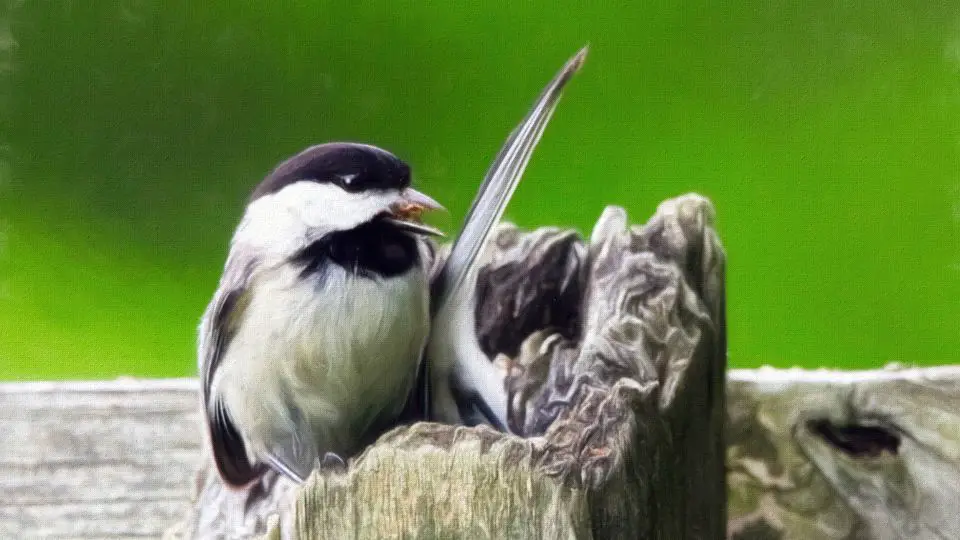
What color should a chickadee bird house be?
Chickadee bird houses are typically best painted in natural and neutral colors. The most suitable colors for a chickadee bird house include:
- Natural Wood Finish: Leaving the birdhouse unpainted with a natural wood finish is a popular choice. Chickadees are attracted to natural materials, and a wooden birdhouse with no paint can blend seamlessly into the surroundings.
- Earth Tones: If you choose to paint the birdhouse, opt for earthy and neutral tones, such as browns, grays, or tans. These colors mimic the natural colors found in trees and vegetation and can make the birdhouse less conspicuous to predators.
- Olive Green: Chickadees are known to be attracted to birdhouses painted in olive green, as this color closely resembles the shades found in their natural habitat.
Where to Place a Chickadee Bird House?
These tiny little songbirds have a long list of predators. Hawks, snakes, weasels, owls, and mice are just a few predators on the long list of chickadee adversaries. Therefore, it’s super important that your nesting box is situated in a safe location, at least 5 feet off of the ground.
In some instances, chickadees even build their nest 20 feet off the ground! Also, make sure that you place your bird house in a location in your yard that is traffic-free. If it’s situated too close to a patio area or in a location where your dogs frequent, it’s likely to scare off local chickadees.

When to Hang A Chickadee Nesting Box?
Be sure to mount your chickadee nesting boxes in the fall or winter so that chickadees have plenty of time to locate their new nesting location. Since chickadees are non-migratory birds, their nesting season starts much earlier than other songbirds.
Many chickadees start scouting new locations in March and building their nests in April and May, especially the Northern black-capped chickadee. If you hang your birdhouse too late in the season, they likely won’t use it until the following year (or you may find that sparrows have taken up residence).
How to Build a DIY Wooden Birdhouse for Chickadees (and chickadees only!)
Materials needed:
- Galvanized screws
- Wood glue
- Cutting tool (hand saw or a circular saw)
- One 8-foot piece of red cedar decking (do not use treated wood)
Instructions:
Step 1. Cut all pieces of your board. You need a backing, two sides, a front, a base, and an angled roof. Cut the backboard to measure at least 16 inches long (the side doesn’t matter as long as it’s long enough to accommodate at least 10 inches. The side should be 9 inches long, and the front 12 inches long.
Step 2. Drill entry hole. You can use a drill hole bit on your power drill. However, it’s super important that you select the correct size. To ensure you are making a home for chickadees (and not house sparrows), make sure that your entrance hole is 1 1/8 inches wide (and no bigger!). Also, ensure that the entrance hole sits at least 10 inches from the bottom of the nest to protect baby Chickadees from predators.
Step 3. Attach all sides using both galvanized screws and wood glue.
Step 4. Secure a 6×6 inch board with brass hinges at a 45-degree angle for an angled roof. Using hinges allows you to lift the top and remove old chickadee nests to prepare for the next breeding season!
Step 5. Place some black oil sunflower and wood shavings inside the nesting box, and mount it in a safe and traffic-free location.
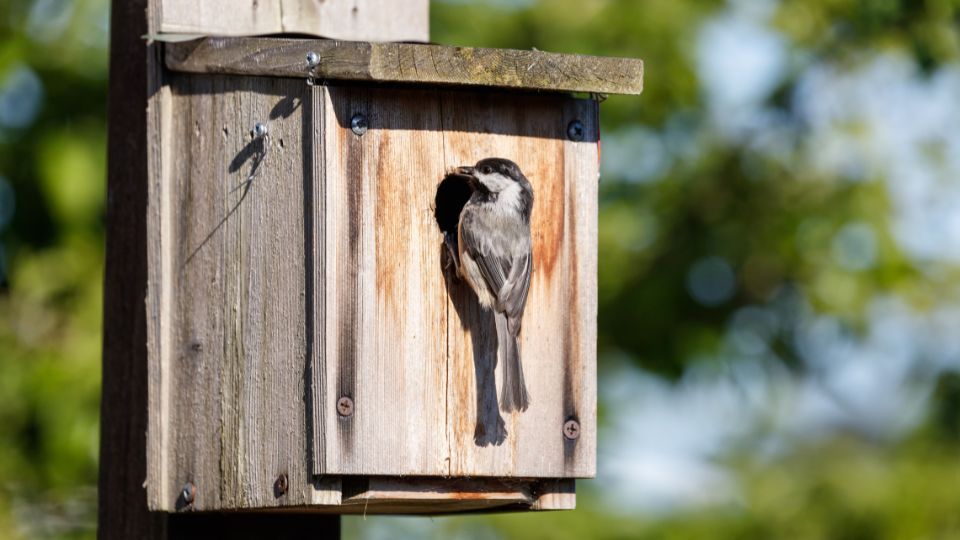
How to Attract a Chickadee to a nesting box?
So, you followed the instructions and built a sound and sturdy chickadee birdhouse. However, you may have noticed that no chickadees deemed your lovely birdhouse home-worthy. What did you do wrong?
There are a few reasons why chickadees won’t use your house, and the solutions are straightforward.
- No food or water source nearby. The most popular human neighborhoods are often located near the best restaurants and watering holes. When placing a home for birds, a great way to entice visitors is to ensure that your yard is a chickadee paradise. Make sure you opt for bird feeders that host their favorite foods, such as sunflower seeds and suet. It would also be great to add one or two birdbaths nearby. Once you attract these birds to nesting sites, they’re sure to call your backyard home.
- Dangerous location. No one wants to live in a precarious area, including chickadees. You want your birdhouse to be fully viewed, but it may be too close to high-traffic areas in your backyard. If it’s too close to a patio or areas where your dogs play – it may be driving chickadees away.
- It’s too big or too small. If your birdhouse is too tiny, birds won’t be able to fit through the entrance hole easily. That makes sense. However, these finicky songbirds also don’t like birdhouses that are too big. Chickadees need a small space to retain heat for their eggs and nestlings. If it’s too big, it won’t stay nice and warm.
- It has a perch. Cavity-nesting birds like the chickadee don’t need perches. Sure, they look quaint, but they’re a security risk. Bird houses built with perches on the front make it much easier for predators to grab onto the perch and slink inside for a snack. Chickadees often cling to the side of the birdhouse or cavity before climbing inside and therefore don’t need (or want!) a front perch.


